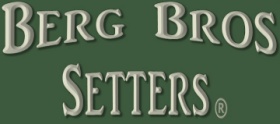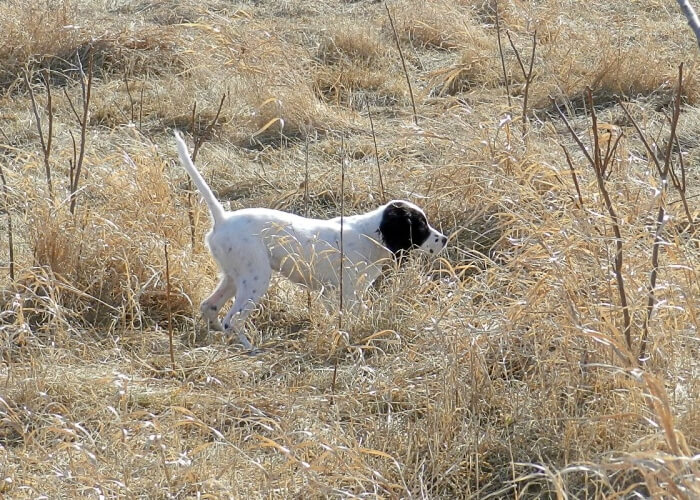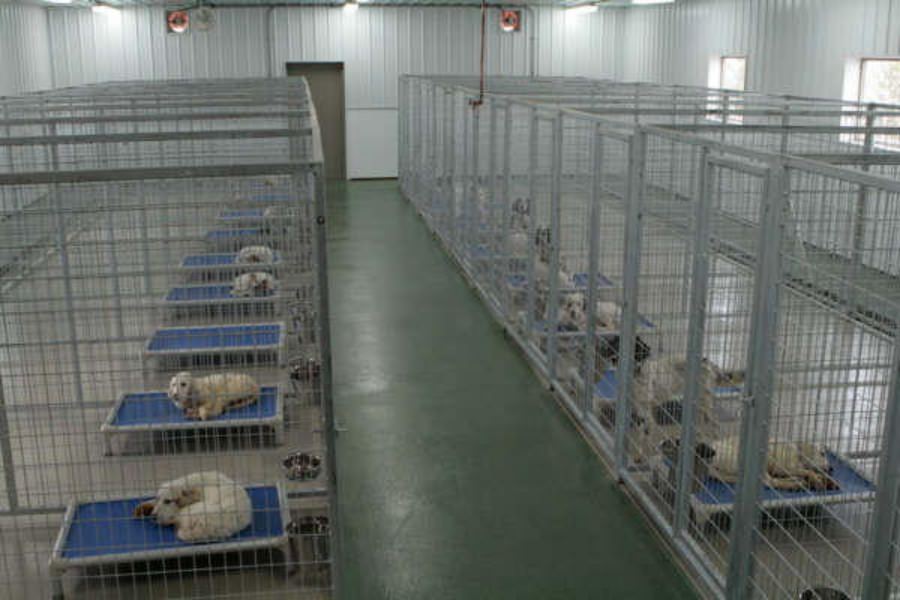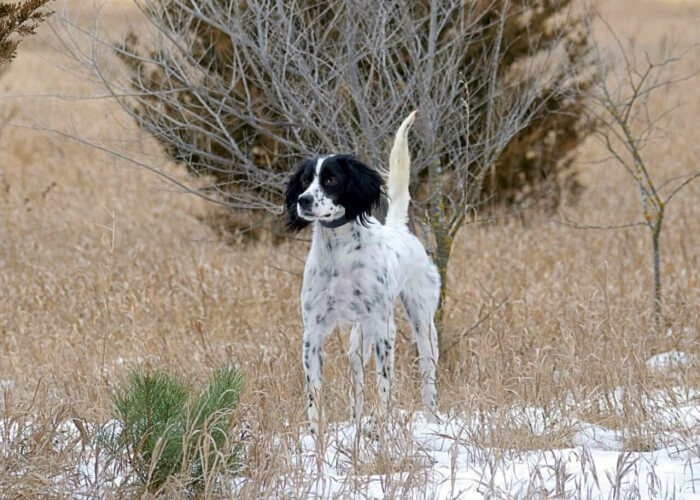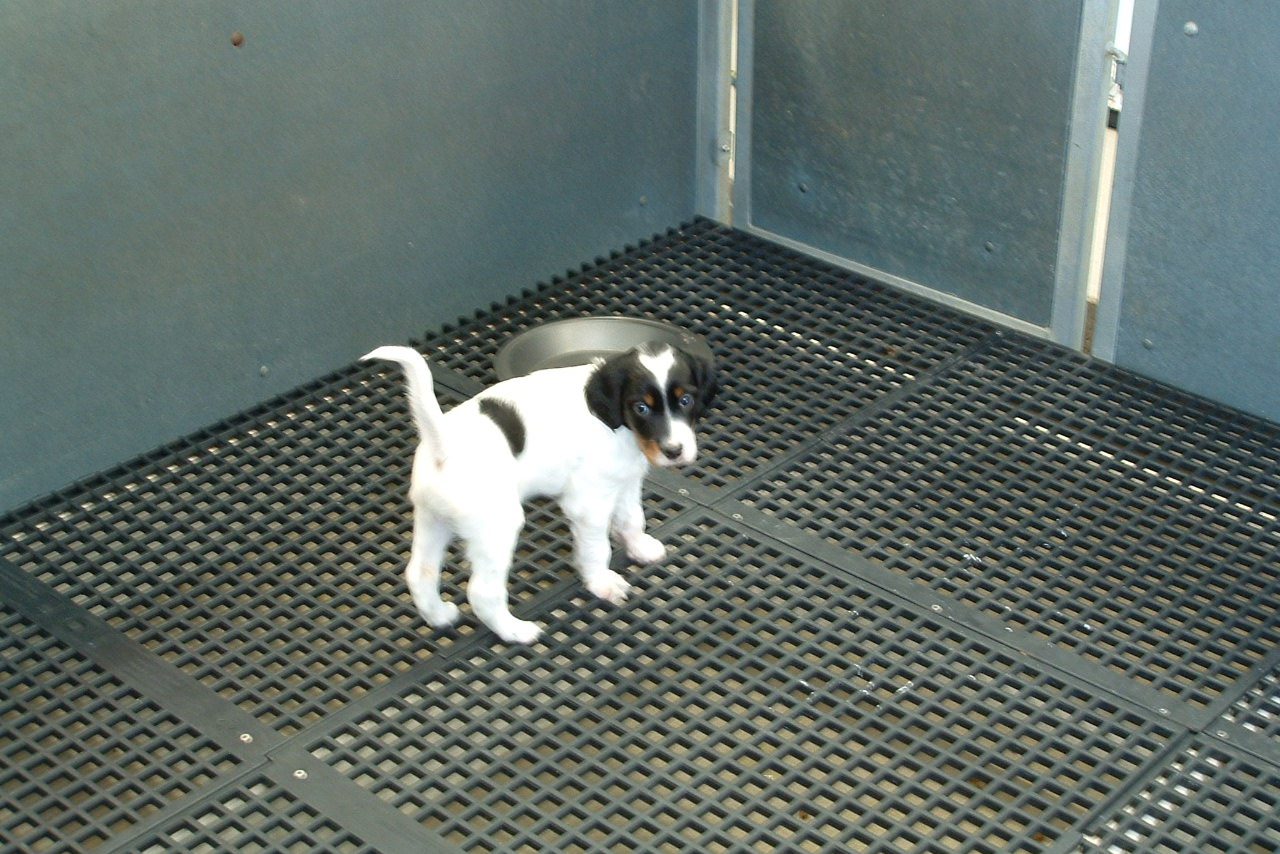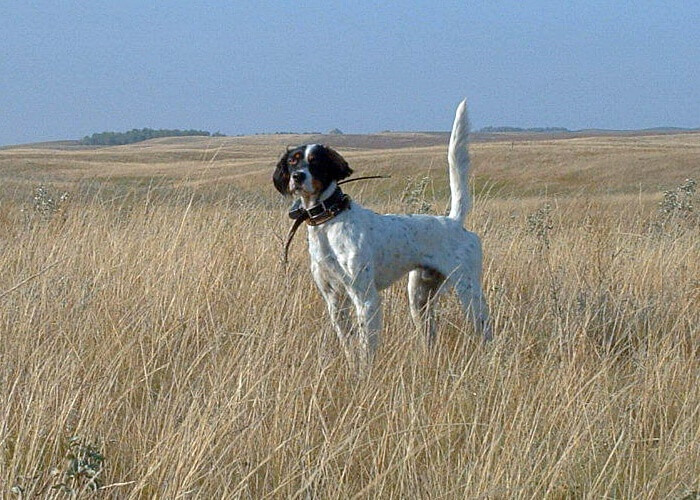Berg Brothers Prodigy getting started in the puppy program.
East Wing of the kennel facility. West wing is identical.
The video link above has a playlist of several 12-26 w/o pups being introduced to birds and gunfire.
Our Approach
Developing your English Setter bird dog should be fun for you and your dog. We will always be patient and avoid the use of excessive force. We understand this concern having employed the services of professional trainers over the years and observing many others prior to making the leap from accomplished Amateur to Professional trainer. Aggressive tactics only serve to confuse the dog and slow the development process. Rough methods also tend to compromise the dogs overall style and performance in the end. We patiently correct mistakes with just enough force to help the dog understand what is expected. In the end, your dog’s potential will be maximized without subjecting your dog to harsh methods.
Second, we take on a limited number of dogs. We are of the opinion the best process is diligent and the dogs are worked at least once every day. Many trainers opt to take on a large number of dogs in order to advertise a lower weekly rate. This only serves to lengthen the process if similar results are to be achieved. There are no short cuts. Reliable performance is the product of a series of lessons that shape your dog’s instinctual abilities into a polished form. This requires a thoughtful and consistent process that is best accomplished by focusing on a limited number of dogs. We also evaluate and consider the best approach for each individual dog.
No two dogs are exactly the same. While milestones in training are roughly the same for every dog, the best approach for each dog is usually not the same. We carefully consider your dog’s progress and reaction to every step in the training process and adjust our training techniques accordingly. There are no time tables in our process. Each dog progresses through our program based on the dog’s individual needs. There is no need to spend a week on something the dog has mastered in two days, just as it is not wise to push forward before the dog is ready.
FACILITY & GROUNDS
Construction of our new kennel facility began in November 2007. The west wing has 16 runs dedicated to training / boarding and the east wing has 20 kennels for dogs that have made our breeding program or are under evaluation. The kennel floor is heated and covered with epoxy paint to insure the most sanitary conditions possible. Each wing also has a separate air circulation system and plenty of natural light. The facility sits on 54 fully fenced acres to assure the safety of your english setter bird dog / family companion. The grounds were in CPR for 10 years. There are nice patches of cover interspersed over the entire area which naturally develops the instinct to seek likely cover. This type of cover allows us to observe nearly 100 of the dog’s actions and reactions.
PUPPY PROGRAM
We think of our puppy program as elementary school for youe English Setter bird dog. It is crucial to a pup’s development to introduce them to birds and training at a very early age. We prefer to start pups between 16 and 24 weeks of age. Pointing dogs that are properly introduced to birds have a considerable development advantage over dogs who encounter a limited number if birds prior to their first hunting season. Most people simply do not have the grounds, birds and time to get a puppy started properly. Consequently the pup’s first season is spent learning the lessons that should have been learned between four and six months of age. We have groomed our training area in a manner that is ideal for bringing out the best in a young dog. Check out the videos of English Setter puppies in our puppy program..
OWNER / HANDLER INSTRUCTION
Some of the most meaningful training we can provide in the form of instruction to the owner / handler. We have developed an interactive program working dogs side by side with our clients. The owner / handler attends several sessions which helps them to understand the various stages of development and the associated techniques required to develop dogs or retain and improve upon the training we have provided. We work their dogs as well as other dogs to demonstrate specific elements or stages in the process. During these sessions we cover everything from whoa training to polishing manners on a dog that is steady to wing and shot. A variety of methods will be demonstrated and most importantly we will cover how to determine which techniques to utilize based on our observations of your dog. We will also cover strategies to employ during the hunting season in order to maximize your dog’s potential and develop polished manners around game.
ADVANCED TRAINING
Advanced training for pointing dogs can be described as developing any form of manners that a pointing dog should not be expected to do naturally. We expect a dog to become steady until the bird is flushed simply through wild bird exposure. However, some hunters prefer the dog to remain steady until the gun is fired. Others prefer the dog remain steady through the shot and fall. These advanced forms of bird work make for a more productive hunt. It also povides more controlled and therefore it’s safer, especially when hunting with younger or less experienced hunters.
Advanced training may also include honoring other dogs on point. Every breeder hopes to produce dogs that back naturally but not all do. Dogs that don’t honor are difficult to work with other pointing dogs as this behavior is disruptive and may cause deterioration of the bracemate’s manners around game. Stop to flush is another advanced form of manners that makes pointing dogs more productive and the hunt more enjoyable. Birds are going to get bumped or flush wild. Stop to flush is a good way to pause the action while you get positioned.
WILD BIRD TRAINING
We take a group of 16 dogs to the prairie each year for wild bird exposure. We have camps in North Dakota and Montana that we alternate between based on bird populations. There is nothing quite like the prairie for getting a young dog going on wild birds. It’s also great for polishing a young dog with a year or two of experience. Both areas are home to Sharptail, Huns, and Pheasants. However, we focus on Sharptail and Huns as they are better for developing manners around game.
The photo above is Berg brothers Prodigy after being broke steady to wing and shot. Note her intensity. Our process applies very little pressure and produces a confident dog with style.
Puppies are kept on raised floors for better cleanliness.
The video link above is a playlist of several advanced training videos.
